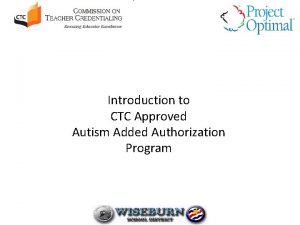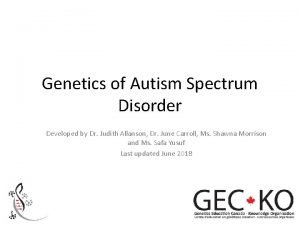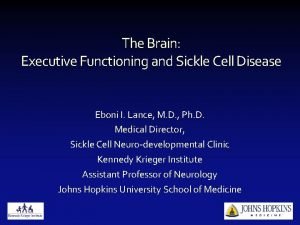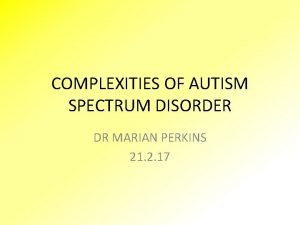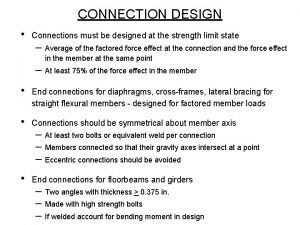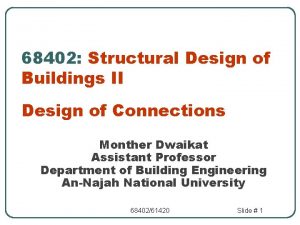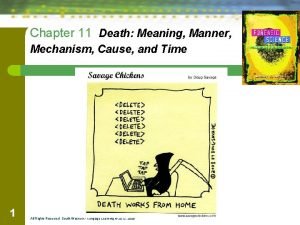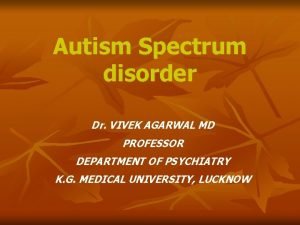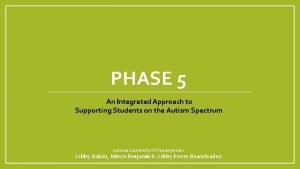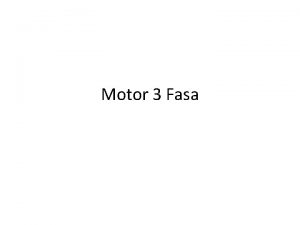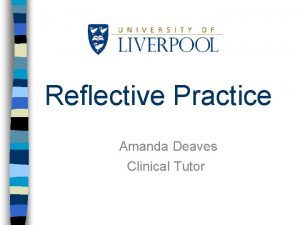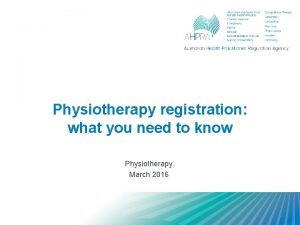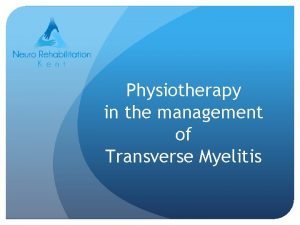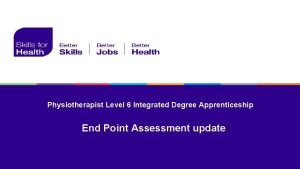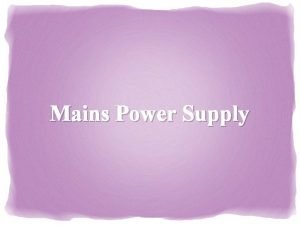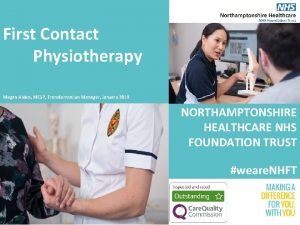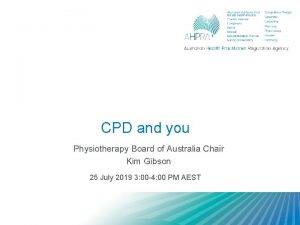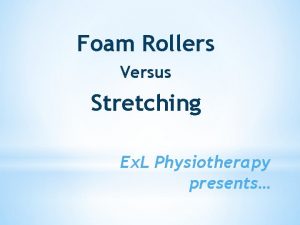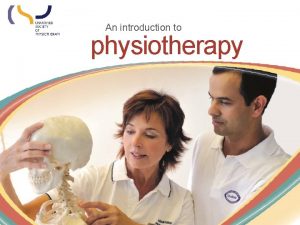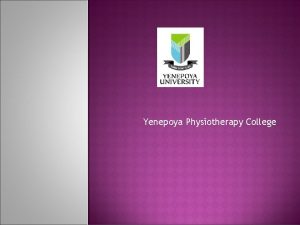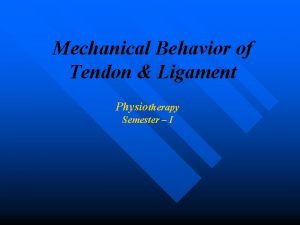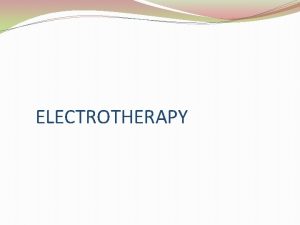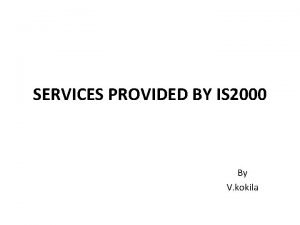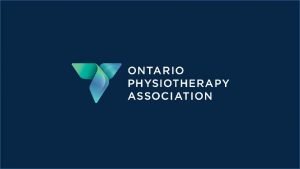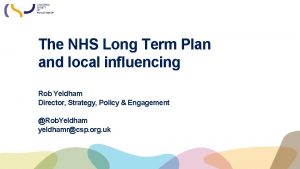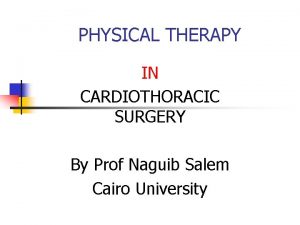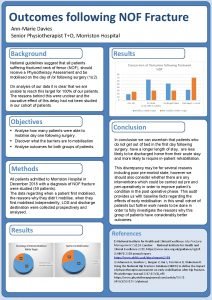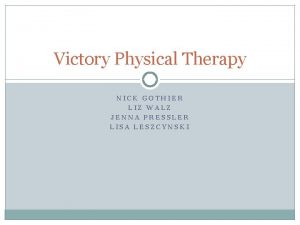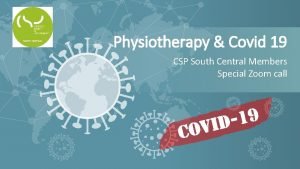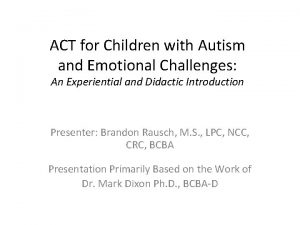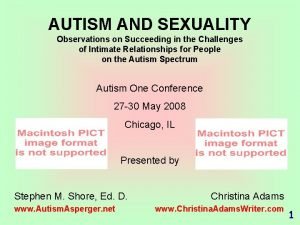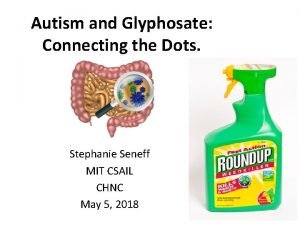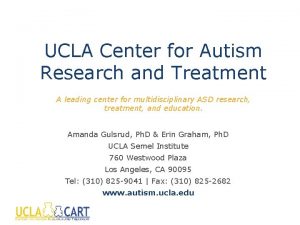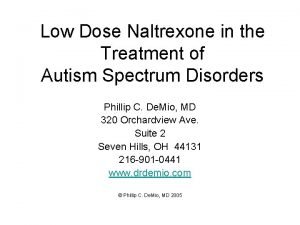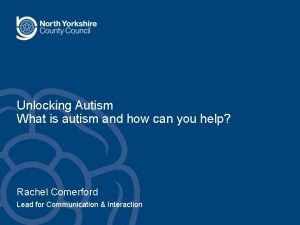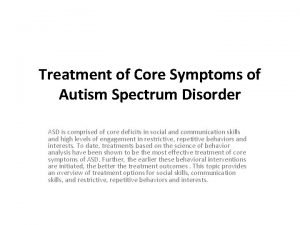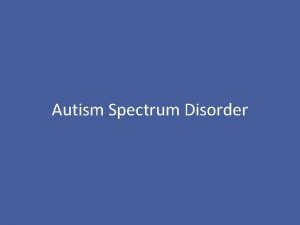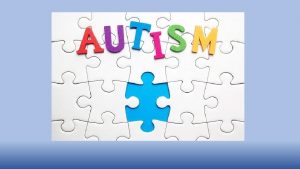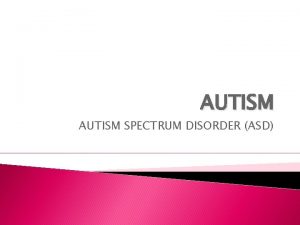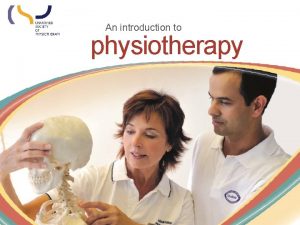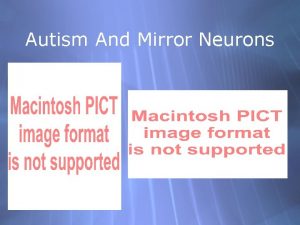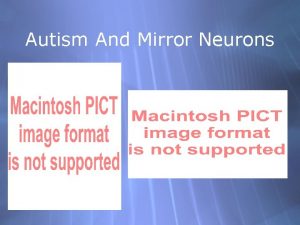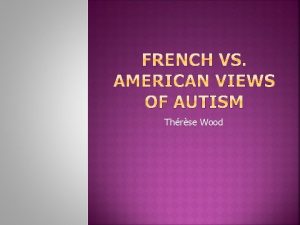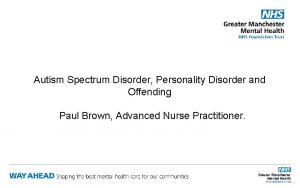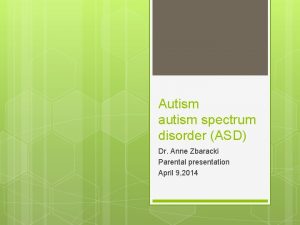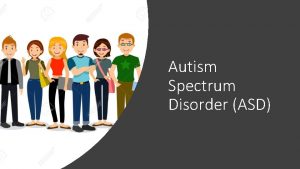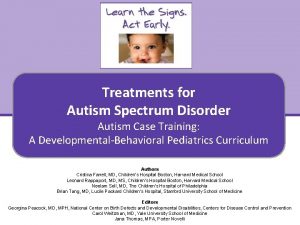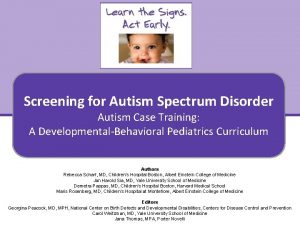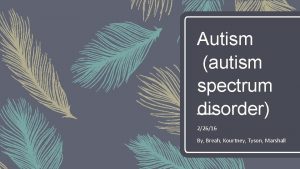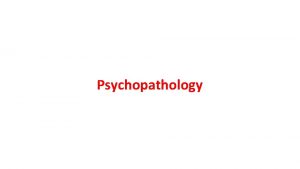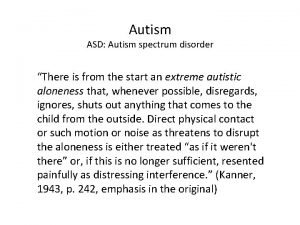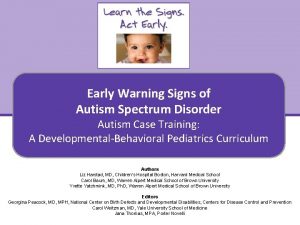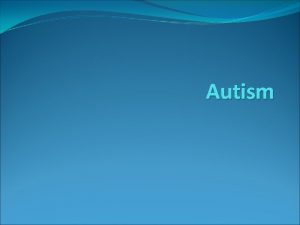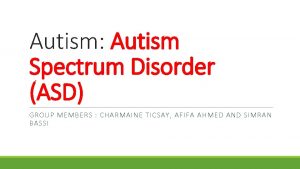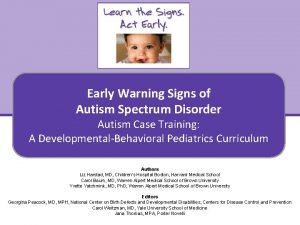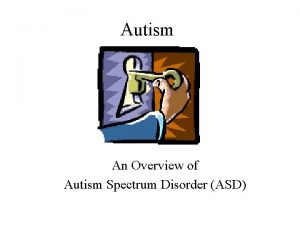Autism Spectrum Disorder and Physiotherapy A Motor Connection
























































- Slides: 56

Autism Spectrum Disorder and Physiotherapy A Motor Connection? Robyn Smith Department of Physiotherapy University of Free State 2012

How common is Autism? • Autism is on the increase • Incidence 1/110 children Statistics are of concern • Boys: 1/70 Autism is not going away and is going to have a huge impact on society in future years


Causes of autism • Epigenetic – disorder has a strong genetic link. • Abnormalities of chromosome 5 have now been linked to an increased risk for autism Strong familial genetic disposition with one autistic child has a 1/20 chance of having another, one twin is autistic 90% chance other is • Has been linked to the mercury preservative in the measles-mumps & rubella vaccination may be contributing factor. No evidence to support this theory. • ? ? environmental factors e. g. endocrine disrupting chemicals found in plastic items “Extreme Male Theory”

Autism Awareness • Little known about autism to date!!! • Challenges faced by parent and health care professionals: • Lack of awareness (World Autism day 2 April) • Lack of treatment facilities • Lack of trained professional persons to help autistic children, burden often falls solely on parents

NB!! What is autism? A complex neurodevelopmental disorder, that is present from early on in life

Defining Autism Spectrum Disorder (ASD) • ASD encompasses a variety of developmental disorders • NB !!! 3 key features in common: ü Impaired socialisation ü Impaired communication ü Repetitive patterns of behavior • ASD is “spectrum disorders” ü affects each child differently ü severity of the symptoms can range from mild to severe ü children with ASD’s development is often uneven with areas of strengths and weakness (Centre for Disease Control and Prevention, 2011; Petrus, Adamson, Block, Einarson, Sharifield & Harris, 2008)


ASD Rett Syndrome Asperger’s syndrome • Affects mainly girls • Initially develop normally • Reversal of development or stagnation • Loss language and hand skills • Caused by spontaneous mutation of defect in the 2 (Me. CP 2) gene • ASD spectrum • Children usually more verbal

Physiotherapy in the dark about ASD? Look at the definition of ASD physiotherapy does not seem relevant in treatment thereof Physiotherapy seems to overlook ASD Ø ASD is not discussed as an entity in physiotherapy textbooks Ø ASD to date is rarely addressed in the physiotherapy training curriculums in South Africa IMPAIRED MOTOR DEVELOPMENT?

THE reality is. . . we are seeing more and more children being referred to our early intervention services with ASD The question is. . . do we know enough about ASD to know what to assess, or how to intervene in these children The facts are. . . the time arrived physiotherapists start solving the puzzle of their role in treatment of ASD

So is ASD a relevant concern for physiotherapists involved in early intervention services? Developmental Disorder IS MOTOR SYSTEM INVOLEMENT Significant rise in incidence Prevalence of 1 in 110 children Front line practitioner status Interdisciplinary approach to early intervention services

What do we know about the type of developmental challenges children with ASD face? • Impaired communication • Impaired socialilisation • Behavioural problems DELAYED AQUISITION OF MOTOR SKILLS

Providing perspective on the movement disorder aspect of ASD Delayed milestone acquisition occurs in approximately 30% Approximately 39% children with ASD have low muscle tone (Ewell, 2011) • The motor symptoms and neurological underpinning thereof are still poorly understood (Wilson, 2011) • Few studies have been done to date about the motor development in children with Autism ( Baranek, 2002)

Why the need to be able to move? “I like to move it, move it Yah I like to Move it“ King Julien Madagascar the movie Dream. Works ®

The need to move it, move it. . • The ability to move and interact with our environment is critical to our ability to develop skills - be it social, emotional, cognitive, or physical • During the foundation years motor skills provide an important vehicle for learning these skills

The need to move it, move it. . • As a child grows the complexity of movement sequences becomes more sophisticated. In children with ASD early motor deficits fly under the radar , but become more obvious as the demands on the motor system become higher Ø Coordinating components complex tasks Ø Copying motor activities Ø Playing imaginative games e. g. hide and seek, musical chairs

The need to move it, move it. . • Lack of motor skills and abilities impact on the child’s ability to participate in the family and community activities including ü self-care tasks ü play ü education/schooling (Redlich, J. 2010; Baranek, 2002; Autism & Oughtisms, 2011)

Understanding why physiotherapy is often overlooked as a treatment option for children with ASD In the light of the significance of the child other difficulties relating communication, behaviour and sensory modulation, the child’s motor difficulties are completely overshadowed. . . . often unintentionally overlooked (Petrus et al. 2008 ; Redlich, 2010)

Movement as a tool: learning through our strengths • Even in the face of motor difficulties , in most of children with ASD the ability to move is a definite strength • Through physiotherapy movement can be used as a vehicle for learning, be a way to have fun and engage these children (Redlich, 2010)

Physiotherapy and ASD: the motor connection • Many children with ASD need help with motor skills and would benefit significantly from receiving physiotherapy. • Appropriate assessment to identify such deficits as part of the interdisciplinary approach to ASD is paramount

How can I identify if a child is at risk for or possibly has ASD during my developmental assessment ? • Front line practitioners • Autism screening tools/questionnaires – The Modified Checklist for Autism in Toddlers M-CHAT (Robins, Fein, & Barton, 1999) or the CHAT-23 questionnaire • Physiotherapists familiar with key clinical features of autism and refer to paediatrician

M-CHAT (Robins, Fein & Barton, 1999) Standardised questionnaire Considered valid and reliable as a screener 87% accurate in identifying a child with Autism Can be used in toddlers between ages of 16 -30 months • 23 questions with yes/no answers • Can be used as part of your developmental assessment • Fail if a child has more than 3 items or 2 critical items as “No” answers • •

Critical questions in the M-CHAT (Robins, Fein & Barton, 1999) • • • Does your child take an interest in other children? Does your child look you in the eye? Does your child point to ask for something? Does your child smile in response to your face or your smile? Does your child respond to his/her name when called? Have you ever wondered if your child is deaf? Does your child sometimes stare at nothing or wander with no purpose? Does your child walk? Does your child make unusual finger movements near his/her face? Can your child play properly with toys without mouthing

Developmental Assessment. . neuromotor focus • Objective measures to evaluate developmental status : • Bayley Scales of Infant Development III • Movement ABC • Bruininks-Oseretsky test of motor proficiency (Wilson, 2011) • Neuromusculoskeletal assessment to included: • • • Muscle tone Muscle strength Joint mobility Soft tissue mobility Neural mobility

Child with ASD may benefit from Physiotherapy if the following indicators are found ion assessment • • Delay in attaining motor milestones Underlying low muscle tone Poor balance, coordination and posture Problems with motor planning Underlying muscle weakness Increased neuromusculoskeletal stiffness Pain impairment (Wilson, 2011; National Autism Association, 2011; Ratliffe, 1998)

Looking at ASD from an ICF perspective. . . Activity/skill limitation Participation limitation Clumsy gait or toe walking Does not attain milestones within predicted age norm Repetitive winging or rocking movements Decreased participation in self care activities Difficulty with playground activities climbing, swinging, hanging, hopping, skipping, walking on a beam Decreased participation in play and recreational activities Difficulty with drinking from a cup, dressing oneself, brushing teeth Keeping bumping into items and falls a lot iin. Influence of personal & environmental factors are important in ASD

Do all children with ASD require physiotherapy? Definitely NOT

So what exactly is the role of Physiotherapy in children with ASD?

Sensory integration difficulties • Children with ASD may have profound sensory processing problems • Hyper-sensitive or under-sensitive resulting in distorted processing of information from the environment Sensory processing problems negatively impact on the child’s ability to develop motor skills and reach milestones

Considerations during physiotherapy. . Often the sensory difficulties need to be addressed first before the motor difficulties can be addressed Therapy environment needs to be “spectrum friendly” OT

Physiotherapy focuses on addressing the underlying problems , not simply symptoms. . . not aiming at developing splinter skills Aim is to help lay the foundations for the development of gross motor skills to support participation in the community and with their peers

1. Addressing low postural tone • Physiotherapy and sensorimotor handling techniques (NDT) can help stabilise postural tone. • Value of NDT as treatment option in children with ASD is poorly researched to date and is still much debated

2. Underlying muscle weakness affecting postural control and stability • Weakness can be addressed by means of functional strengthening, weight training and other age appropriate activities addressing core muscle groups

3. Tight soft tissue structures and joint stiffness • Physiotherapy soft tissue techniques and stretching can assist in lengthening tight soft tissue structures • Joint mobilisation techniques e. g. OMT can be used to mobilise stiff joints

4. Develop the ability to do typical child activities • Encourage and facilitate typical activities or skills relevant to the child’s age e. g. walking, running, jumping, skipping • Typical age appropriate games e. g. hop-skotch, running race and clambering • Roughhousing on mat e. g. pillow fight, playful wrestling on mat • Ball activities e. g. soccer, tennis

5. Improve balance and coordination • Physiotherapists can assist the child in improving their static and dynamic balance by strengthening core stabilisers and addressing low postural tone. • Specific goal directed activities will also help the child to improve their proprioception and balance • Activities e. g. walking on a line or beam, standing on one leg, jumping, skipping, balance board activities

6. Develop motor planning skills • Child with ASD often battles to time, sequence and execute complex movements or motor tasks. • Researchers still unsure of the nature of the motor planning problems ? the plan itself defective or interpretation of information provided by sensory systems needed for the execution of complex motor tasks is deficient

6. Develop motor planning skills • Physiotherapy help the child in developing motor planning skills • The use of obstacle courses are wonderful teaching tools to help a child with ASD to follow multiple step directions and develop planning skills • Activities like these also help children in organising sensory information Help them find a path through an activity

7. Motivate and encourage an active lifestyle Compared to their peers children with ASD tend to be less active and are more inclined to being overweight • Children with ASD prefer sedentary pursuits e. g. computer games, TV • Only 20% of children with ASD exercise regularly according to parent reports (Wilson, 2011)

7. Motivate and encourage an active lifestyle • Benefits of formal and informal exercise or sport in children with ASD include: – improved cardiovascular fitness and endurance, – weight control, – improved attentiveness, – improved self-esteem and increased peer interaction, – reduced self stimulating behaviours, – help deal with the frustration and sensory difficulties. (Baranek, 2008; Wilson, 2011 ; Hawthorne, 2011; Petrus et al. 2008)

Value of aerobic exercise in Autistic children • It is suggested that aerobic exercise physiologically modulates stereotypical behaviour through the release of specific neurotransmitters in the brain (Baranek, 2008; Petrus et al. , 2008) Sparked interest use of physical activity and exercise as an intervention strategy for stereotypical behaviour in ASD

Use of physical activity to improve behaviour in children with autism • Exercise should be incorporated in the child and family’s routine • Children may initially have difficulty in coping with and exercise programme -one needs to identify and modify personal and environmental barriers to participation. • Suggested activities include running, trampolining, martial arts, cycling, swimming (hydrotherapy) , ball activities, therapeutic horse riding. (Wilson, 2011; O’ Connor, French, & Henderson, 2000. )

Use of physical activity to improve behaviour in children with autism • Research on the value of exercise in improving behaviour in children with ASD is limited to date (Wilson, 2011; O’ Connor, French, & Henderson, 2000)

Considerations during physiotherapy. . • Therapy sessions must be structured • Need to teach child a route through activities, break down a task or activities into manageable components • Make use of goals directed activities • Make use of aspects that motivate the child or are of interest. One can make use of their obsessions for positive gains here. • Keep instructions simple, talk clearly. Child must focus on you when giving instructions, look you in the eye

Considerations during physiotherapy. . • Be patient and give child a chance to respond • Be aware of how the child behaves when faced with change, and develop ways of handling this behaviour • Encourage verbal and other appropriate responses from the child • Try and involve the child in social interactions (Ratliffe, 1998; Redlich, 2010; Ewell, 2011)

The role of physiotherapy in the management of ASD is currently poorly researched and described ? ? ? Opinions regarding the role of physiotherapy in the management of children with ASD remain contradictory (Baranek, 2008)

Parting thoughts. . . • Physiotherapy intervention is indicated for children with ASD who have definite motor delays/deficits and low muscle tone. • Not every child with ASD requires physiotherapy. . But screening is essential in order to identify problems • Physical activity and play should be encouraged for all young children with ASD and their families • More research is needed regarding the value of physiotherapy intervention in this specific population

Some educational aspects to use. . . • Try and teach child to concentrate -go back to basics. • Break tasks down into its simplest components to limit anxiety and stress • Tell them when an activity starts and when it is over • Social stories often help • Visual timetable –breakdown of activities and must run in order • Objects of reference • First and then boards • Zoning of areas • Communication books, boards and devices

Occupational therapy • Address sensory integration problems • Cognitive stimulation very important • Perceptual activities SENSORY ISSUES !!!! • Deep pressure and brushing with a soft brush often work well to calm children down • “Bear Hug” • Unrolling ear • Blowing things e. g. Whistle, bubbles etc

Medication • Various medications can be used in the treatment of Autism • Mood stabilising medications e. g. Tegretol, Lithium • Antipsychotic medications e. g. Risperdal • Antidepressant and anti-anxiety medications e. g. Prozac • Stimulant medications for ADHD e. g. Ritalin • Non Stimulant medications for ADHD e. g. Strattera

THANK YOU

References • Adams, JB; Edelson, SM; Grandin, T & Rimland, B. 2004. Advice for parents of young autistic children. Working paper. • forgotten physical impact of autism. Available online at; http: //autismandoughtisms. wordpress. com • Baranek, GT. 2008. Efficacy of sensory and motor interventions for children with autism. Journal of Autism and Developmental disorders. Vol. 32 (5)October 2003 pp 397 -422 • Centre for Disease Control and Prevention. USA. 2011. Autism Spectrum Disorder (ASD) Available online at: http: //www. cdc. gov/ncbddd/autism/index. html • Downing, PG. 2010. Physical therapy can benefit some children with autism. 18 July 2010, Brownsville Herald

References • Ewell, V. 2011. Physical therapy for Autistic Children. Healthmango. available online at: http: //www. healthmango. com/autism/physicaltherapy-for-autistic-children/ • Hawthorne, D. 2011. Autism and exercise. Autism today. Available online at http: //www. autismtoday. com/articles/autism_excercise. htm • Ming, X; Brimacombe, M & Wagner, GC. 2006. Prevalence of motor impairment in autism. Brain and Development, Vol. 29, Issue 9, October 2007 pp 565 -570 • O’ Connor, J; French, J & Henderson, H. 2000. Use of physical activity to improve behaviour in autism. Palaestra. Summer 200 o Vol. 16 nr. 3

References • Petrus, C; Adamson, R; Block, L; Einarson, SJ; Sharifnejad, M & Harris, SR. 2008. Effects of exercise intervention on stereotypic behaviours in children with Autism Spectrum Disorder. Physiother Can 2008: 60; 134 -145 • Ratliffe, KT (ed). 1998. Sensory processing and cognitive disorders in childhood in clinical Paediatric Physical Therapy. A guide for the Physical Therapy Team pp 324 -327 • Redlich, J. 2010. Autism Spectrum Disorders and Physical therapy: The motor connection. Austism spectrum, winter 2005 • Redlich, J. 2010. Movement as a tool. How can we learn through our strengths. Our journey thru Autism

References • Wilson, CA. 2011. The role of physical therapy for individuals with autism Spectrum Disorders • Smith, R. 2011. Children with Developmental Coordination Disorder. Physiotherapy Department, UFS, lecture notes (unpublished) • Images courtesy of Google images, 2011 • Madagascar characters images (Dream. Works) courtesy of Google images, 2011
 Added authorization in autism spectrum disorders
Added authorization in autism spectrum disorders Sensory processing disorder dsm
Sensory processing disorder dsm Are there different types of autism
Are there different types of autism Autism spectrum disorder
Autism spectrum disorder Autism spectrum disorder adhd
Autism spectrum disorder adhd Autism physiotherapy
Autism physiotherapy Puberty and autism spectrum disorders
Puberty and autism spectrum disorders Social pragmatic communication disorder
Social pragmatic communication disorder Text to text connections examples
Text to text connections examples Weakness of bohr's atomic model
Weakness of bohr's atomic model Bolted connection
Bolted connection Shear plane in bolted connection
Shear plane in bolted connection Slip critical bolted connection
Slip critical bolted connection Somatization disorder dsm 5
Somatization disorder dsm 5 Fetal alcohol spectrum disorder
Fetal alcohol spectrum disorder Spectrum disorder
Spectrum disorder Spectrum disorder
Spectrum disorder Absorption spectrum
Absorption spectrum Sambungan motor 3 fasa
Sambungan motor 3 fasa A motor unit consists of
A motor unit consists of Pony motor starting method diagram
Pony motor starting method diagram Principle of synchronous motor
Principle of synchronous motor Motor parts name
Motor parts name Ee 216
Ee 216 Solent physiotherapy
Solent physiotherapy Swob analysis
Swob analysis Physiotherapy registration requirements
Physiotherapy registration requirements Transverse myelitis physiotherapy
Transverse myelitis physiotherapy Degree apprenticeships physiotherapy
Degree apprenticeships physiotherapy What is a mains supply
What is a mains supply Physiotherapy introduction
Physiotherapy introduction Megan alden
Megan alden Physiotherapy cpd portfolio examples
Physiotherapy cpd portfolio examples Triangle physiotherapy
Triangle physiotherapy Supporting rope in suspension therapy
Supporting rope in suspension therapy Exl physiotherapy
Exl physiotherapy Aintree hospital physiotherapy
Aintree hospital physiotherapy Introduction of physiotherapy
Introduction of physiotherapy Yenepoya physiotherapy college
Yenepoya physiotherapy college Stress strain curve physiotherapy
Stress strain curve physiotherapy Low frequency current in physiotherapy
Low frequency current in physiotherapy Kokila physiotherapy clinic
Kokila physiotherapy clinic Ontario physiotherapy association
Ontario physiotherapy association Advanced physiotherapy practitioner
Advanced physiotherapy practitioner Nhs long term plan physiotherapy
Nhs long term plan physiotherapy Cardiothoracic
Cardiothoracic Morriston hospital physiotherapy
Morriston hospital physiotherapy Victory physiotherapy
Victory physiotherapy Covid special
Covid special Self as context
Self as context Autism and chess
Autism and chess Autism and relationships
Autism and relationships Glyphosate and autism
Glyphosate and autism Ucla autism research
Ucla autism research Naltrexone and autism
Naltrexone and autism The autism iceberg
The autism iceberg Core symptoms of autism
Core symptoms of autism
